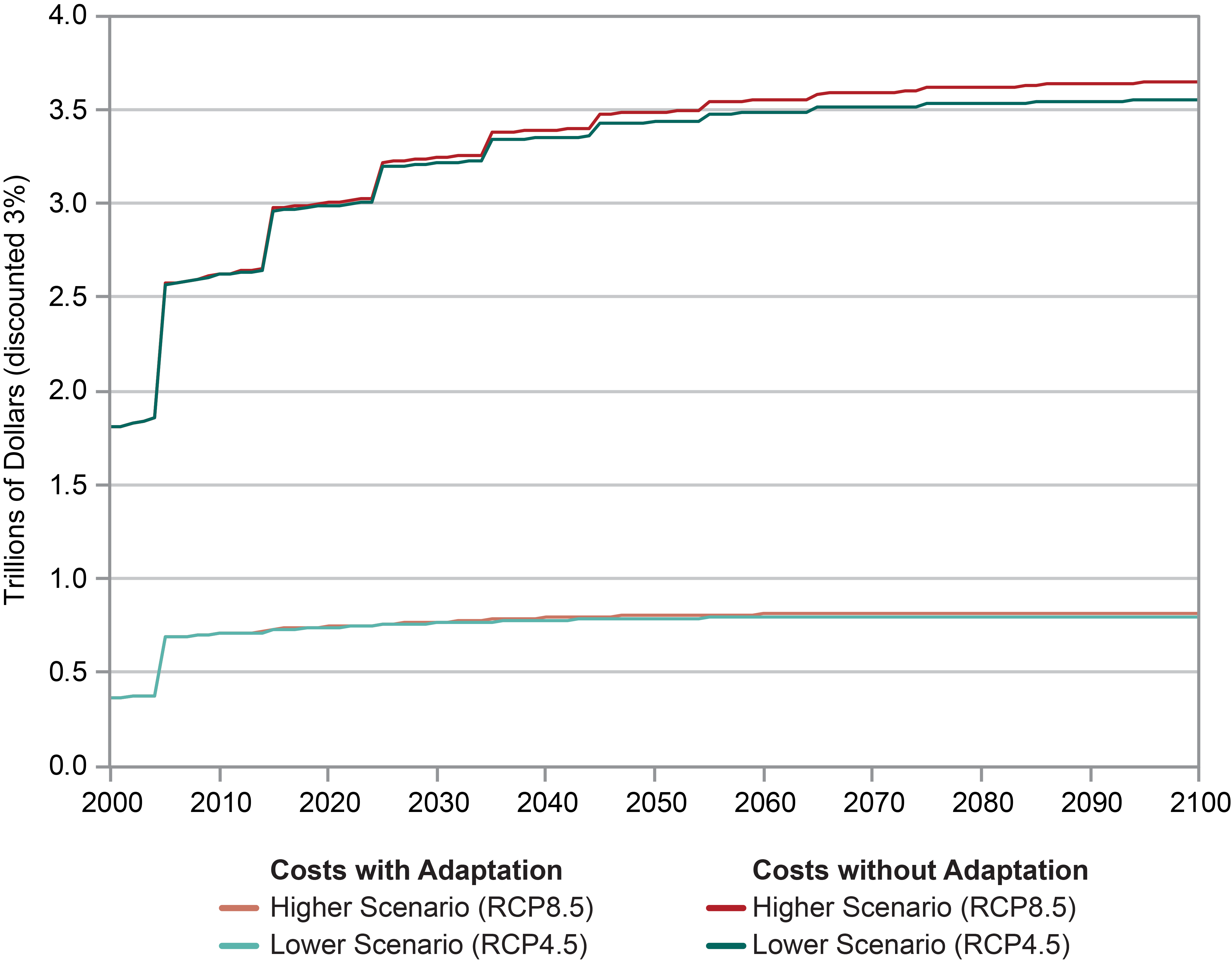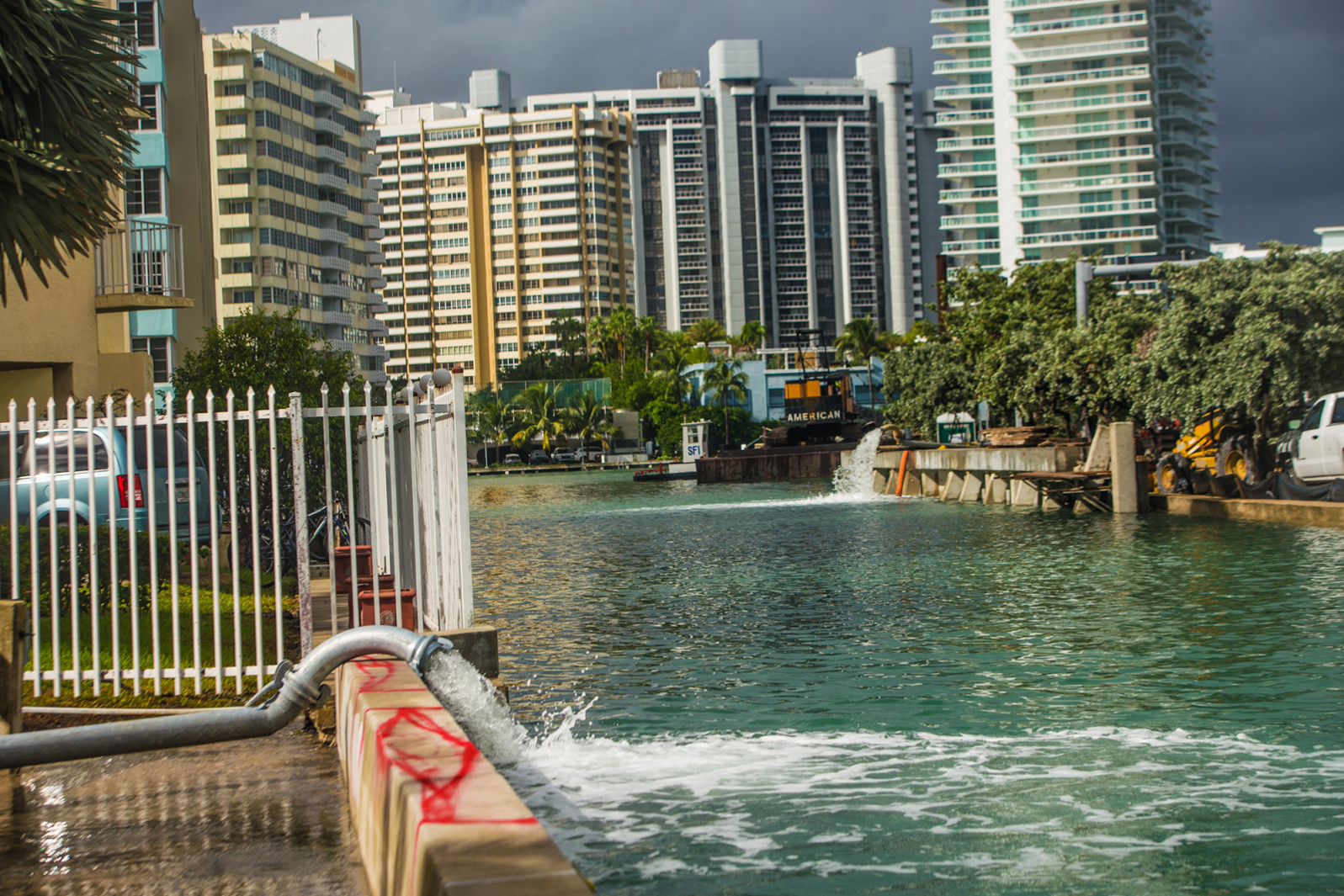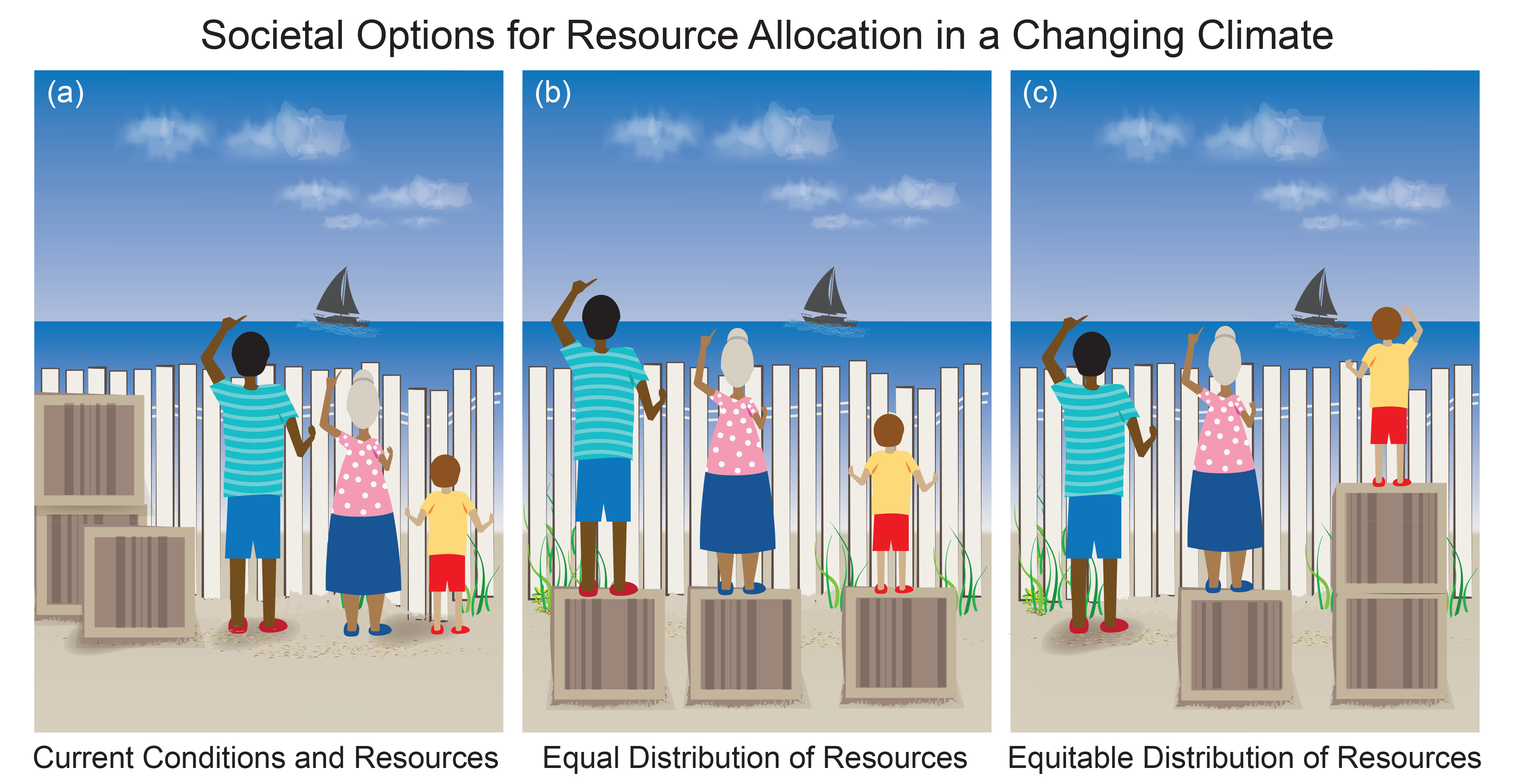The selection of the author team for the Coastal Effects chapter took into consideration the wide scope and relative sufficiency of the Third National Climate Assessment (NCA3) Coastal chapter. With input and guidance from the NCA4 Federal Steering Committee, the coordinating lead authors made the decision to convene an all-federal employee team with representation from key federal agencies with science, management, and policy expertise in climate-related coastal effects, and to focus the content of the chapter on Key Messages and themes that would both update the work conducted under NCA3 and introduce new themes. For additional information on the author team process and structure, refer to Appendix 1: Process.
A central component of the assessment process was a chapter lead authors’ meeting held in Washington, DC, in May 2017. The Key Messages were initially developed at this meeting. Key vulnerabilities were operationally defined as those challenges that can fundamentally undermine the functioning of human and natural coastal systems. They arise when these systems are highly exposed and sensitive to climate change and (given present or potential future adaptive capacities) insufficiently prepared or able to respond. The vulnerabilities that the team decided to focus on were informed by a review of the existing literature and by ongoing interactions of the author team with coastal managers, planners, and stakeholders. In addition, the author team conducted a thorough review of the technical inputs and associated literature. Chapter development was supported by numerous chapter author technical discussions via teleconference from April to September 2017.
Key Message 1: Coastal Economies and Property Are Already at Risk
America’s trillion-dollar coastal property market and public infrastructure are threatened by the ongoing increase in the frequency, depth, and extent of tidal flooding due to sea level rise, with cascading impacts to the larger economy. Higher storm surges due to sea level rise and the increased probability of heavy precipitation events exacerbate the risk. Under a higher scenario (RCP8.5), many coastal communities will be transformed by the latter part of this century, and even under lower scenarios (RCP4.5 or RCP2.6), many individuals and communities will suffer financial impacts as chronic high tide flooding leads to higher costs and lower property values. Actions to plan for and adapt to more frequent, widespread, and severe coastal flooding would decrease direct losses and cascading economic impacts. (Likely, High Confidence)
Description of evidence base
Significant impacts to coastal communities, properties, infrastructure, and services are already occurring in low-lying areas of the country such as Miami Beach and Fort Lauderdale in Florida; Norfolk, Virginia; and Charleston, South Carolina.61,125,126,127,128
Satellite and tide gauge data show that sea level rise (SLR) rates are increasing,36 and research has shown that this increase is driven by emissions that are warming the planet.129,130 The latest SLR science7,36,48,52 finds that even if RCP2.6 were achieved, it is likely that global mean sea level will rise by 1.5 feet by 2100; under RCP8.5, a rise of about 3 feet is within the likely range for 2100. Recent probabilistic studies and assessments of future SLR and rapid ice loss from Antarctica find that although a low probability, there is a possibility of upwards of 8 feet of rise by 2100 under a high-emission, extreme melt scenario.36,37,49,50,51,52
Applying digital elevation models to determine the extent and number of communities and the amount of property and infrastructure that would be impacted by different amounts of SLR illustrates the magnitude of investments that are at risk.56,57,126,131,132,133,134 These same analyses demonstrate the savings that could be achieved by lowering emissions. Finally, implementing adaptation measures to ensure that public infrastructure is resilient to current and future flood scenarios will be tremendously expensive. To date there are few economic sectoral models that quantify damages under alternative climate scenarios,57,134 so additional modeling work would be useful.
The importance of coastal economies and infrastructure to the overall national economy is well documented (for example, the National Oceanic and Atmospheric Administration’s [NOAA] Economics: National Ocean Watch; NOAA port data), as are the economic ripple effects of impacts to property markets.57,58,133,135,136 Similarly, much has been written about how the National Flood Insurance Program has subsidized development in risky areas and how raising flood insurance rates to be actuarially sound could make it impossible for many coastal residents to afford flood insurance.58,137,138,139,140 The evidence for the economic savings provided by adaptation investments is still fairly limited but growing.54,57,59,141
Major uncertainties
The main source of uncertainty is in the magnitude of SLR that will occur and how it will vary across different regions, which depend in part on the amount and speed with which global society will reduce emissions. While global climate models and SLR models have improved since NCA3,142 uncertainty remains about exactly how much SLR will occur where and by when with different emissions levels. Even though there is uncertainty about the magnitude, the probabilistic approach to the SLR technical report to the Fourth National Climate Assessment,36 together with impacts already documented around the country from high tide flooding,143 gives us high confidence of the threat to coastal property and infrastructure. Adaptive responses to SLR risk and impacts, including individual action and public policy development, are also significant sources of uncertainty. For example, there is uncertainty about future development patterns in coastal regions, including both new development and migration inland, which has the potential to change the magnitude of coastal property and infrastructure at risk. The U.S.-specific research on potential migration away from the coast due to SLR and other climate impacts is very limited.102
Future flood insurance policy is another specific source of uncertainty. Under the latest legislation (the Federal Emergency Management Agency’s Homeowner Flood Insurance Affordability Act140), flood insurance rates are gradually rising; development of new policies related to affordability or to the requirement to carry flood insurance in order to have a federally backed mortgage could change behaviors.
While figures for the economic value of certain sectors dependent on the ocean and Great Lakes are available through NOAA’s “Economics: National Ocean Watch,”144 similar information for the economic and social value of other sectors, such as real estate and insurance/reinsurance, would be beneficial for the audience of this assessment report, especially decision-makers.
Description of confidence and likelihood
There is very high confidence that the frequency and extent of tidal flooding is already increasing and will continue to increase with SLR and that this flooding threatens the trillion-dollar coastal property market and public infrastructure. There is limited research using varied methods to quantify the direct and indirect economic impacts that will be experienced under different amounts of SLR. Nevertheless, there is a high level of confidence that these losses will be dramatic under SLR associated with the higher emission scenario (RCP8.5) and significant even under lower scenarios (RCP4.5 or RCP2.6), based on property values and geographic exposure to inundation. U.S. economic history provides strong evidence that extensive property market losses have the potential to impact businesses, personal wealth, and mortgage-related securities. Similarly, historic disaster events such as hurricanes and earthquakes provide a very high level of confidence that impacts to critical transportation and energy networks will harm the economy. Considering the uncertainty inherent in future human behavior and policy responses, including flood insurance policy, it is possible that individuals and institutions will act to reduce future flooding, to lessen the exposure and sensitivity of critical assets, and to create policies that assist individuals and businesses most impacted; hence, there is medium confidence that many coastal communities will be transformed by 2100 under any scenario and that many individuals will be financially devastated under lower emission scenarios (RCP4.5 or RCP2.6). Considering current exposure of assets and the latest SLR science, large economic losses in coastal regions that will generate cascading impacts to the overall economy of the United States are considered to be likely. The overall high confidence is the net result of considering the evidence base, the well-established accumulation of economic assets and activities in coastal areas, and the directional trend of sea level rise.
Key Message 2: Coastal Environments Are at Already at Risk
Fisheries, tourism, human health, and public safety depend on healthy coastal ecosystems that are being transformed, degraded, or lost due in part to climate change impacts, particularly sea level rise and higher numbers of extreme weather events (highly likely, high confidence). Restoring and conserving coastal ecosystems and adopting natural and nature-based infrastructure solutions can enhance community and ecosystem resilience to climate change, help to ensure their health and vitality, and decrease both direct and indirect impacts of climate change (likely, high confidence).
Description of evidence base
Multiple lines of evidence have determined that coastal environments are critical to support coastal fisheries, tourism, and human health and safety.74,81,83,85,86,87,92,145,146,147 These ecosystems are some of the most threatened on the planet and are being transformed, degraded, or destroyed due to climate change (including rising temperatures, rising sea levels, and ocean acidification)148,149,150,151,152,153 and due to other human stressors such as nutrient pollution, habitat and biodiversity loss, and overfishing.
There is growing evidence that one part of the solution to help coastal ecosystems and human communities be more resilient to climate change, including SLR and increasingly intense or frequent storms, is to conserve or restore coastal habitats such as wetlands, beaches and dunes, oyster and coral reefs, and mangroves74,75,81,83,85,86,87,88,92,145,146,154 because they help to attenuate waves, decrease wave energy, and reduce erosion.81 In addition to restoring or protecting natural habitats, there is also a growing interest in, and body of research regarding expectations for, performance in using a combination of natural and built (called hybrid, or nature-based) features, such as living shorelines, to protect coastal communities.83,88,90,91,155,156
Major uncertainties
The exact amount of coastal habitat loss that is due to climate change versus other human stressors or multiple stressors can be hard to ascertain, because these stressors are all acting simultaneously on coastal habitats. Nevertheless, it is clear that climate change is one of the important stressors impacting coastal habitats and leading to the degradation or loss of these ecosystems, such as the loss of coral habitats to bleaching events due to rising ocean temperatures and the loss of coastal wetlands due to more intense storm events.
The use of natural and nature-based infrastructure (NNBI) to improve coastal resilience is being implemented in many different states (for example, the use of living shorelines is expanding in Maryland, North Carolina, New Jersey, Louisiana, and other states, and the Rebuild by Design competition is implementing a variety of coastal resilience projects in New York and New Jersey), although there remain some uncertainties about how much storm and erosion risk reduction is provided by different techniques or projects and in different settings. The efficacy of NNBI remains uncertain in many instances; comprehensive monitoring, particularly during and after storms, would be required to ascertain how well these features are functioning for protection services. This monitoring could inform future coastal resilience planning and decisions, including the benefits, costs, and/or tradeoffs involved in considering NNBI options.157
Description of confidence and likelihood
There is high confidence that coastal ecosystems are particularly vulnerable to climate change. They have already been dramatically altered by human stressors, as documented in extensive and conclusive evidence; additional stresses from climate change point to a growing likelihood of coastal ecosystems being pushed past tipping points from which they will not be able to recover. The overall high confidence is the net result of considering the evidence base, the dramatically altered ecosystems from human stresses, and the directional trend of sea level rise.
Key Message 3: Social Challenges Intensified
As the pace and extent of coastal flooding and erosion accelerate, climate change impacts along our coasts are exacerbating preexisting social inequities, as communities face difficult questions about determining who will pay for current impacts and future adaptation and mitigation strategies and if, how, or when to relocate. In response to actual or projected climate change losses and damages, coastal communities will be among the first in the Nation to test existing climate-relevant legal frameworks and policies against these impacts and, thus, will establish precedents that will affect both coastal and non-coastal regions. (Likely, Very High Confidence)
Description of evidence base
Reports and peer-reviewed articles are clear that socioeconomic challenges are being both driven and intensified by climate change.33 Particularly on the coasts, where there are multiple risks to contend with, including hurricanes, SLR, shoreline erosion, and flooding, the high cost of adaptation is proving to be beyond the means of some communities and groups.97,100,158 In areas where relocation is more feasible than in-place adaptation, coastal tribes of Indigenous people are at risk of losing their homes, cultures, and ways of life as they seek higher ground (Ch. 15: Tribes, KM 3).98,159 New tools are being developed to quantify risks and vulnerabilities along the coast. For example, tools such as the Coastal Community Social Vulnerability Index160 and the Coastal Economic Vulnerability Index161 measure the social vulnerability of hurricane- or flood-prone areas to better quantify and predict how climate-driven changes are likely to impact marginalized groups. The Coastal Flood Exposure Mapper tool162 supports communities that are assessing their coastal hazard risks and vulnerabilities with user-defined maps that show the people, places, and natural resources exposed to coastal flooding. The U.S. Environmental Protection Agency’s Environmental Justice Screening and Mapping Tool provides consistent national data that allows the agency to protect the public health and environments of all populations, with a focus on traditionally underserved communities.163 Moreover, involving diverse representation in the adaptation process through community-driven resilience planning115 is likely to be a part of developing adaptation strategies that are fair and just.99,164
Major uncertainties
The main uncertainty for this Key Message is predicated on how different types of coastal effects (chronic flooding versus storms) will impact areas and communities along the coast. The degree of variation between communities means that it will be challenging to predict exactly which communities will be affected and to what extent, but the evidence thus far is clear: when it comes to climate-driven challenges and adaptation strategies, areas that have traditionally been underrepresented will continue to suffer more than wealthier or more prominent areas. Large-scale infrastructure investments are made in some areas and not others, and some local governments will not be able to afford what they need to do.
The variability in state laws and the pace at which those laws are evolving (such as shoreline management plans and setback policies for structures in the coastal zone) create major uncertainty.
Description of confidence and likelihood
There is very high confidence that structural inequalities in coastal communities will be exacerbated by climate change and its attendant effects (for example, storms, erosion). In the absence of clear policies and legal precedent, questions about land ownership and home ownership will persist.







